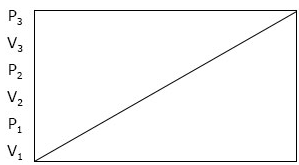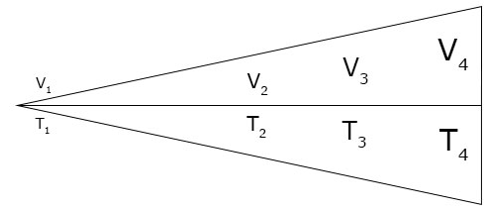The kinetic theory of matter postulates that the tiny Particles of matter are continually moving and so possess kinetic energy. An increase in temperature causes an increase in the average kinetic energy of the particle.
Dalton’s experimental evidence shows that chemical compounds consists of molecules, which are groups of atoms of various elements. The gas laws which explained the physical behaviour of gases can be explained by kinetic theory of gases. This theory describes the behaviour of an ideal or perfect gas. This is to say that the kinetic theory of gases explains quantitatively the properties of gas molecules and in so doing put up the following assumptions.
- A gas consists of very tiny particles (usually molecules and atoms).
- The cohesive forces of the gas molecules are negligible.
- These particles are in constant random and rapid motion in straight lines.
- As a result of these movements, collisions occur between the molecules and also with the walls of the container, hence the molecules exert pressure. No energy is lost when collision occupy. This means that the collisions are perfectly elastic.
- The space between the molecules is very large compared to the size of the molecules. The molecules therefore have negligible (almost zero) volume compared to the volume of the container.
- The average kinetic energy per molecule is the same for all gas samples at any given temperature. The absolute temperature of the gas is a measure of the average kinetic energy of the gas particles.
EVALUATION
- The kinetic theory of matter postulates ……………………..
- When the temperature of the particles of the molecules increases, what happens to kinetic energy?
- Enumerate the six assumptions if the kinetic theory of matter.
THE APPLICATION OF KINETIC THEORY
The kinetic theory is useful in several respects and such aspects includes;
- It provides reasonable explanations for the behaviour of gas.
- It accounts for the gas laws
- It explains important phenomenon such as diffusion
- It provides a fundamental equation for gases.
PV=13NMC2
EVALUATION
- Mention four applications of kinetic theory of matter.
PHENOMENA TO ILLUSTRATE THE KINETIC THEORY OF MATTER
The following phenomena illustrate the kinetic theory of matter
- Dispersion
- Evaporation
- Diffusion:
- Brownian motion
- Osmosis
- Tyndall effect
- Effusion
EVALUATION
- Define the term matter.
- State the three state of matter.
- Explain two out of the three main sate of matter.
- List four importance of kinetic theory.
- Give assumptions of kinetic theory of matter.
BOYLE’S LAW
The relationship between volume and pressure of a gas was first started by Robert Boyle in 1662.
Boyle’s law states that the volume of a given mass of gas is inversely proportional to its pressure, provided that the temperature remains constant.
According to Boyle’s law, volume of a gas increases as the pressure decreases and vice versa.
This relationship is independent of the nature of the gas and it can be expressed mathematically as:
V∝1P∴V=kp
or PV=k
Where V = Volume at pressure P
K = A mathematical constant
For a given mass of a gas, the product of its pressure and its volume is always a constant. If the pressure of a given mass of gas increases, its volume will decrease by a similar proportion and vice versa, as long as the temperature remain constant. This relationship can also be expressed mathematically as:
P1V1=P2V2
Where V1 = Volume at pressure P1
V2 = Volume at pressure P2
Boyle’s law can still be re-stated as: ‘The pressure of a given mass of gas is inversely proportional to its volume, provided the temperature remains constant. Boyle’s law can further be illustrated with the diagram below, showing that when P is increasing, V is decreasing and when P is decreasing, V is increasing.

P1 = Initial pressure
P2 = Final pressure
V1 =Initial volume
V2 = final volume
Graphical representation of Boyle’s law

Graphical Representation of Boyles Law
Worked examples
- 375cm3of a gas has a pressure of 770mmHg. Find its volume if the pressure is reduced to 750mmHg.
P1V1=P2V2 (Boyle’s law)
P1 = 770mmHg
P2 = 750mmHg
V1= 375cm3
V2 = ? (new volume of gas)
P1V1=P2V2V2=P1V1P2=770×375750=385cm3
The new volume will be 385cm3
100cm3 of a gas has pressure of 1 atmosphere. Determine the volume of the gas at 5 atmospheres keeping the temperature constant.
Solution: since T is constant, we are to use Boyle’s law.
P1 Initial pressure = l atmosphere
P1 Final pressure = 5
V1 Initial volume = 100cm3
V2 (required quantity)
Recall: V2=P1V1=P2V2
V2=P1V1P2=100×15=20cm3
EVALUATION:
- A given quantity of gas occupies a volume of 228cm3at a pressure of 750mmHg. What will be its at atmospheric pressure if temperature is kept constant?
- A given mass of gas at 550C has a pressure of 3.6 x 104Nm-2and occupies a volume of 1.8dm3. What volume will it occupy if its pressure is increased to 4.8 x 104Nm-2 if the temperature is kept constant?
CHARLES’ LAW
The effect of temperature changes on the volume of a given mass of a gas at a constant pressure is described by Charles. Charles’ law states that the volume of a given mass of gas is directly proportional to its temperature in Kelvin, provided that pressure remains constant.
The volume of the gas decreases as the temperature decreases, and increases as the temperature increases.
Mathematically, the law can be expressed as:
V∝T∴V=kT
or VT=k
Where V = volume
T = Kelvin Temperature
K = mathematical constant
A Representation of Charles’s law

For a direct relationship, when the temperature increases, the volume will also increase at the same rate and vice versa, at constant pressure .The diagram above shows that when V is decreasing, T is also decreasing and when V is increasing, T is also increasing thus, making the quotient constant.
Charles’s law can be represented graphically has shown below.

If we divide the varying gas volumes by the corresponding temperature in Kelvin, the result would always be a constant. This relationship can also be expressed in another form.
V1T1=V2T2∴V2=T2V1T1
Where V1 is the volume at temperature T1
V2 is the volume at temperature T2
ABSOLUTE ZERO
This is the temperature at which the volume of a gas is theoretically zero..At this temperature there is no motiom of any form and all gases have been liquefied or solidified. The value of the temperature is -2730C.
TEMPERATURE CONVERSION
- To convert from Celsius scale to Kelvin scale, add 273 i.e. T = 0C + 273. This is because O0C = 273K.
- To convert from Kelvin scale to Celsius scale, subtract 273. i.e 0C = T − 273.
Where T = Temperature in Kevin
0C = Temperature in Celsius.
Examples:
- Convert the following Celsius temperature to Kelvin temperature.
(a) 1000C (b) 00C (c) -570C
Solution
Recall: T = 0C + 273
(a) 1000C = (100 + 273) = 373k
0C =(0 + 273) = (0 + 273) = 373k
(b) −570c = (−57 + 273)k = (273 − 57) = 216k
- Convert the following Kelvin temperatures to Celsius temperature.
(a) 298k (b) 405k (b) 285k (d) 0k
Solution
Recall 00c = k – 273
298k = (298 – 273)0C = 250C
405k = (405 – 273)0C = 120C
0k = (0 – 273)0C = − 2730C
Worked examples on Charles’s law
- A gas occupies a volume of 20.0dm3at 373k. Its volume at 746k at that pressure will be?
Here pressure is constant. Charles’s law will apply.
V1 = 20.0dm3
T1 = 273k
T2 = 746
Recall Charles’s law V1T1=V2T2V2=T2V1T1V2=20×746273=40.0dm3
EVALUATION:
- State Charles’s law
- Express the two laws mathematically
- Draw two graphs to illustrate Charles’ law.
post your answers to the forum for review
Read our disclaimer.
AD: Take Free online baptism course: Preachi.com 